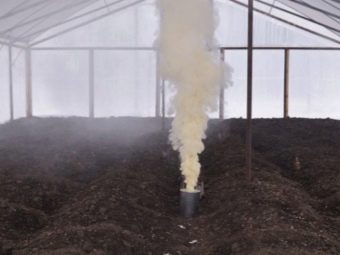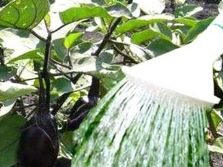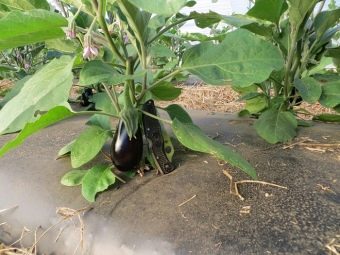Eggplant in a polycarbonate greenhouse: planting and care

Growing eggplants is a rather complicated process.Experienced and novice gardeners have long understood that this vegetable is considered one of the most difficult to grow in a polycarbonate greenhouse. Having studied the main problems that they had to face during the cultivation of eggplants, you can avoid a huge number of unpleasant incidents and get a fairly decent and high-quality crop. The main thing is to follow all the necessary rules of care and properly water the next harvest.
Planting dates
In order to grow eggplants in a greenhouse made of polycarbonate to be of the highest quality and most successful, it is necessary to adhere to the basic rules and terms of sowing. It is the timely planting of seeds and seedlings of this crop that allows to get the proper result at the output. Otherwise, you can not only get a low-quality crop, but also be left without it. The ideal option is to plant seeds for seedlings at the end of winter or early spring. Most experienced gardeners prefer planting eggplant seeds in early March, when the soil is slightly frozen, but is already suitable for nourishing the seeds. In the ground in the greenhouse, the grown seeds should be relocated only after the heating and other systems necessary for the greenhouse will be equipped. After sowing, seedlings should be in warm conditions for at least 100 days. As for the average term of ripening of fruits, they fluctuate around 4 months.
Soil preparation
Before you start planting seedlings, it is imperative to prepare the soil and properly handle it. If the preparation is carried out in the winter season, then it is necessary to clean the land from the remnants of plants and various debris, then pour it with copious amounts of water in order to wash off any excess fertilizing and trace elements. In addition, it is imperative to carry out disinfection from diseases, which is carried out by spraying the solution on the inner surface of the greenhouse. To obtain such a solution, you must use two tablespoons of copper sulphate and about 10 liters of water at room temperature. If the landing is carried out in the spring season, then the earth should be thoroughly gouged and leveled.
Soil processing depends largely on its type. For example, if you use high-quality black soil, you can not make any fertilizer, but in the presence of loamy earth, in any case, you will have to use potassium sulfate or other similar substances. In some cases, you can limit the use of sawdust. Before you start growing eggplants in a polycarbonate greenhouse, you need to check the level of soil acidity. Ideally, it should not be more than 6.5. If this indicator exceeds the established rate, then two tablespoons of dolomite flour per square meter should be added to the soil.
If necessary, retain moisture in the soil is to use brown peat, which has proven itself for similar purposes.
A distinctive feature of eggplants is that they can be grown not only in stationary greenhouses, but also in ordinary greenhouses or film constructions. And the best way is to use the seedling method, which is the most effective and efficient. In addition, the use of this method greatly simplifies the process of growing and accelerates it. The soil must be prepared in the autumn, completely clearing the land and the land from the remnants of other plants. If the territory is located on an open area, then the land must be treated from bacteria. If the greenhouse is characterized by the presence of a closed ground, it is necessary to wash it with abundant water, then disinfect.
Modern gardeners and gardeners know a huge number of ways to disinfect the soil, among which are some of the most popular.
- Heat treatment, which is one of the most simple. You just need to cultivate the land with hot water or steam. The technique is effective only in small areas, as it requires a fairly large amount of water and time.
- Biological disinfection, the essence of which is to use the processes of natural decay to combat pathogens and bacteria. To do this, remove the top layer of soil and lay slurry there.
- Heat treatment. The essence of this treatment is to use bleach. In addition, you can limit the use of formalin, previously diluted in water. Recent studies show that the most effective is copper sulphate, which must be diluted in water with a ratio of 60 g per 10 l. Taking into account the possibility of poisoning with similar substances, in the process of treating the soil, you must be extremely careful and follow the safety rules precisely. And after processing, the soil must necessarily be covered for a day in order to achieve the highest quality result.
Landing pattern
In order for eggplants to grow beautiful and tasty, you must clearly follow the rules for planting. Agrotechnics in this case is quite simple, has distinctive features that need to pay close attention.
There are several key secrets.
- Selection of the optimal grade. To date, the product range includes more than 20 varieties of this vegetable, which can be grown in a greenhouse made of polycarbonate. The main requirement is that vegetables boast resistance to cold, otherwise they will have to spend huge amounts of money on heating, which reduces the expediency and rationality of growing eggplant to nothing.
- Selection of the optimal type of polycarbonate greenhouse construction. Most gardeners advise to give preference to structures that have a special window, allowing you to control the temperature and get the optimal microclimate.
- If the greenhouse is located in regions with a harsh climate, then to maintain the optimum temperature it is necessary to install special equipment. In cold regions, it is impossible to do without heating equipment, which includes not only the heating and irrigation system, but also the control of humidity levels.
- Greenhouses should be in a place where the light day for the plant will be at least 12 hours. If there is a shortage, then you must first take care of this and install special lamps.
- Watering should be done only with warm water at room temperature, and irrigation should begin as early as the fifth day after planting. The ideal option is considered if the foliage, in general, is not sprayed.
- Careful attention should be paid to the quality of the soil, which should be not only fertilized, but also with a loose structure. Only in such a case will it be possible to get the highest quality product at the outlet.
- In the process of growing a culture, it is necessary to control the level of obtaining nutritional supplements, making them every week.
Novice gardeners will be quite easy to deal with eggplant farming in greenhouse conditions, where plants are reliably protected from the effects of wind, direct sunlight and other negative effects of the weather. It is necessary to carefully study the planting scheme of seedlings, which also has a direct impact on the quality of the yield. And in the process of landing, the main thing is to prevent the occurrence of neglect of the beds, since this may cause a decrease in yield and its infection with various fungal infections.If a standard polycarbonate greenhouse is used, then no more than 5 plants can be placed per square meter, but only if the room is heated. If the design can not boast the presence of heating equipment, then this figure is reduced to 3 pieces.
When forming beds, it is necessary to adhere to other requirements. For example, the spacing in the aisle should be not less than 60 cm, and the distance between the holes in a row can be about 30 cm. And the depth of planting of seedlings raises the most questions among novice gardeners. In this case, there is no optimal option, but it is best to polish it in the range from 15 to 20 cm. The optimal temperature mode is +20 degrees, because under such conditions young shoots can adapt and grow. If the soil temperature is less than +15 degrees, then there can be no question of any increase.
If we are talking about a variety of eggplant with bushes, it is best to give preference to the scheme with a chess hole arrangement, the interval in which must be at least 60 cm.
How to care?
Planting eggplant is only part of an important process, because to get a quality crop you need to ensure an adequate level of plant care and pinch in time. This includes watering with plenty of water, the use of special fertilizer and airing, as well as ensuring that the crop is protected from the negative effects of pathogens and bacteria. It should be noted that in the greenhouse for eggplant, you can create more comfortable conditions than in the open field. Due to this fact, plants can easily grow into huge bushes, if they were properly formed. In addition, the competent formation greatly simplifies the process of care and allows you to increase the yield of this crop.
The ideal option is considered to form a two-stem, so you can get at least 10 fruits from one plant. But in one stalk it is possible to form only in cases when it comes to tall varieties or if the plants are rather weak, and the greenhouse design does not allow using a long stalk. Watering eggplant is also important in the process of caring for it. For example, hybrid variants, which are distinguished by small growth, are characterized by a minimum ability to pinch. It is necessary to pass them in order not to mold them, but rather simply tie them to the supports.
Careful attention in the process of caring for eggplants should be given to the level of moisture in the soil, for which it must constantly receive the necessary amount of water. Eggplants are characterized by a shallow root system, so they drain the soil extremely quickly, if water does not flow regularly, the crop will deteriorate quickly. Watering should be carried out at least 2 times a week, and in the presence of dry and hot weather - more often. If an ovary appears, the soil should be watered at least twice a week with warm water. It is best to do this in the morning when the soil is still wet, but it already needs quite a lot of water.
It is extremely important to prevent the ingress of moisture on the leaves, which may be the cause of their decay in the future.
When growing eggplants in a greenhouse made of polycarbonate, they must be fed. It is not necessary to do this too often, but at least 4 times a season they should get additional nutrients. And for this you need to use both organic and chemical fertilizers. Experts recommend immediately after disembarkation to use special trace elements and complex fertilizers. They allow you to saturate the soil and seedlings with the necessary amount of nutrients and protect against pathogens.
Secondary treatment should be carried out after rooting seedlings, which takes at least two weeks. The following fertilizing should be done in the flowering process and it is best to use specialized complex fertilizer for this. On the modern market there are a huge number of manufacturers who produce fertilizer for different varieties of eggplants, so that every summer resident can choose the best option for himself.
If eggplants grow too long, you can use another feed. It is best to give preference to liquid organic fertilizer, which in a given period of crop growth will be the most effective and efficient.
Diseases and pests
Even in the process of growing eggplants in a polycarbonate greenhouse, they are exposed to various pathogens and pests. It is best not to deal with them not after they appear, but to carry out prevention, which ensures the safety of the crop. But the main thing is to strictly observe the rules of cultivation of this vegetable crop, to conduct airing and disinfection in a timely manner. It should be noted that in most cases, eggplant contamination occurs due to improper ventilation of the greenhouse, resulting in significantly reduced humidity, which leads to the appearance of rot.
At the stage of formation of the structural features of the greenhouse, it is necessary to correctly position the ventsso that you can create a stream of clean air during ventilation. It is he who will circulate in the future inside the structure, thereby ensuring the growth of plants. Before the start of each season, it is imperative that the greenhouse be completely disinfected, treating its surface with the help of specialized chemicals. In order to ensure reliable protection of the crop and prevent its loss, it is necessary several times a week to carefully examine the plants. If any signs of contamination are detected, steps should be taken immediately to save the vegetables. Among the main diseases for eggplants can be identified tobacco mosaic, gray rot and phytophtora. As for the pests that can usually be found in such cultures, it is a spider mite, Colorado potato beetle and whitefly. And to protect against them, you can use both special chemicals and glue traps.
In any case, it is best to carry out preventive work initially in order to ensure the most reliable protection of the crop and prevent its loss.
Growing eggplants in greenhouse conditions is a rather complicated process that needs to be approached with all the responsibility. The main thing is to comply with all the necessary rules for crop safety, timely conduct airing and processing of bacteria, and also pay close attention to competent seating.
See how to grow eggplants from seed to harvest in the next video.






































